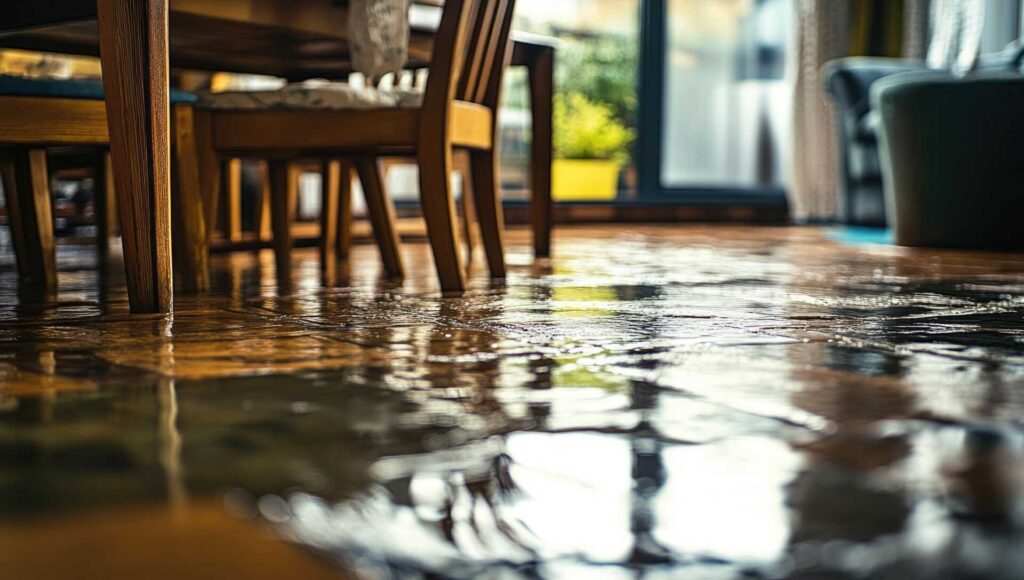
Contents
It’s interesting how a simple pipe leak can lead to extensive water damage if not addressed promptly. You must approach water cleanup methodically, starting with evaluating the damage and identifying potential safety risks. Understanding the right techniques can make a significant difference in the outcome. As you navigate each step, you’ll uncover critical methods that ensure effective cleanup and long-term prevention. What’s the first step you should take to mitigate the damage?
Key Takeaways
- Identify the source of water intrusion and address it to prevent further damage.
- Use absorbent materials and barriers to contain the spread of water effectively.
- Remove standing water promptly with a wet/dry vacuum or submersible pump.
- Clean and sanitize all affected surfaces to prevent mold growth and contamination.
- Regularly inspect and maintain your property to prevent future water damage.
Assessing the Damage and Safety Risks
When you’re faced with water damage, evaluating the situation is essential to ensure both your safety and the effectiveness of the cleanup process.
Start by identifying the source of the water intrusion—whether it’s a burst pipe, flooding, or appliance malfunction. This helps you gauge the severity and potential risks involved.
Next, check for electrical hazards; if the water’s near electrical outlets or appliances, cut off the power to avoid shocks.
Assess the extent of the damage to walls, floors, and personal belongings. Look for signs of mold growth or structural issues, as these can pose health risks long after the water’s gone.
Document everything for insurance purposes, noting the affected areas and any visible damage.
This thorough assessment protects you and paves the way for a more effective and targeted cleanup approach that fosters a sense of control and community in managing such crises.
Containing the Water Spread
To effectively contain water spread during a cleanup, you need to act quickly and strategically. Begin by evaluating the affected area to identify the source of the water. Using absorbent materials like sandbags or porous barriers can help restrict movement and limit further damage.
Placing these barriers in strategic locations—such as doorways or low points—will create a more controlled environment for recovery efforts.
Next, consider using tarps or plastic sheeting to cover larger surfaces, preventing water from seeping into other areas. If possible, create a drainage path that redirects water to a designated spot.
It’s crucial to monitor the situation continuously, as conditions can change rapidly. Engaging with a team during this process fosters a sense of community and shared responsibility.
Removing Standing Water Efficiently
Efficiently removing standing water is essential for minimizing damage and expediting the recovery process.
Begin by evaluating the volume of water and determining the best removal method. For smaller areas, a wet/dry vacuum can be highly effective. Make sure to choose a vacuum with sufficient horsepower to handle the task, ideally at least 5-6 HP.
For larger volumes, renting a submersible pump can be a game-changer. These pumps can rapidly evacuate water, saving you time and reducing potential damage.
Always remember to wear appropriate safety gear, including gloves and boots, to protect yourself from contaminants.
If the standing water is significant, consider enlisting professionals who specialize in water removal; they possess the expertise and equipment necessary for thorough cleanup.
After removing the bulk of the water, verify proper ventilation in the area to facilitate drying.
This proactive approach will help you reclaim your space efficiently and effectively.
Cleaning and Sanitizing Affected Areas
Once you’ve removed standing water, the next critical step is cleaning and sanitizing the affected areas to prevent mold growth and eliminate harmful bacteria. Start by using a mixture of water and a suitable disinfectant to scrub surfaces thoroughly. Make certain you pay attention to porous materials, as they can harbor pathogens.
Here’s a quick reference table for cleaning supplies:
| Surface Type | Recommended Cleaner | Sanitizing Method |
|---|---|---|
| Hard Floors | Bleach solution | Mop with disinfectant |
| Carpets | Carpet cleaner | Steam clean (if possible) |
| Walls and Ceilings | All-purpose cleaner | Wipe down with cloth |
| Furniture (non-wood) | Mild detergent | Wipe with disinfectant wipes |
After cleaning, ensure proper ventilation to aid drying. Regularly check for any signs of mold to maintain a safe environment.
Preventing Future Water Damage
While you can’t control every potential source of water damage, implementing proactive measures can greatly reduce risks.
Start by regularly inspecting your property for leaks and vulnerabilities. Addressing issues early can save you significant time and money.
Consider these essential strategies:
Maintain Gutters and Downspouts: Regularly clean and repair them to direct water away from your foundation.
Install a Sump Pump: This can help manage groundwater levels, especially in basements prone to flooding.
Seal Windows and Doors: Properly sealing these areas prevents water intrusion during heavy rain and storms.
Review
Mastering effective water cleanup techniques isn’t just about immediate relief; it’s about understanding the science behind moisture control. Prompt and thorough cleanup can greatly reduce mold growth, which thrives in damp environments. You’re restoring your space and safeguarding your health by evaluating the damage, containing water, and sanitizing thoroughly. Embracing these methods can prevent future incidents, proving that a proactive approach is essential in mitigating water-related risks.
Recent Posts
Top Flood Damage Repair Extraction Techniques
When floodwaters rise, the clock starts ticking, much like a ticking time bomb for your
Advanced Methods for Flood Damage Repair
Imagine a family returning home after a severe storm only to find their basement submerged
5 Best Flood Damage Repair Extraction Techniques
Many people underestimate the complexity of flood damage repair, especially when it comes to extraction
